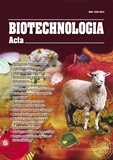ISSN 2410-7751 (Print)
ISSN 2410-776X (Online)

Biotechnologia Acta Т. 18, No. 3, 2025
P. 69-72, Bibliography 9 , Engl.
UDC 661.8…782:579.873.6
doi: https://doi.org/10.15407/biotech18.03.069
SODIUM BENZOATE ASSIMILATION BY RHODOCOCCUS AETHERIVORANS UCM AC-602
T.M.Nogina, O.G.Kisten, V.S.Pidgorskyi
Zabolotny Institute of Microbiology and Virology of of the National Academy of Sciences of Ukraine, Kyiv
Sodium benzoate (SB) is a widely used preservative (E211) and also serves as an active ingredient in several pharmaceuticals. Prolonged exposure to SB can disrupt aquatic ecosystems, adversely affecting aquatic organisms and potentially human health.
Aim. To investigate the features of sodium benzoate biodegradation by the Rhodococcus aetherivorans UCM Ac-602 strain and assess the ecological safety of the toxicant and its degradation products for higher plants.
Methods. The concentration of SB was determined using high-performance liquid chromatography. Fatty acids composition was analyzed by gas chromatography–mass spectrometry. Catalase activity was measured spectrophotometrically, and cell membrane permeability was assessed using crystal violet. Phytotoxicity was evaluated via a rapid assay using wheat (Triticum aestivum L.) as a test plant.
Results. The R. aetherivorans UCM Ac-602 fully utilized 0.5 g/L of SB within 7 days. A twofold decrease in the C18:1 cis-9 fatty acid and a 1.7-fold increase in 10Me-C18:0 were observed during growth on SB. Changes in catalase activity and membrane permeability during SB assimilation contributed to cellular protection against the toxic effects of the substrate. Neither SB nor its metabolites exhibited phytotoxic properties.
Conclusions. The main mechanisms of adaptation of R. aetherivorans UCM Ac-602 to SB assimilation are modifications in fatty acid profiles, changes in catalase activity, and alterations in membrane permeability. SB and its degradation products were shown to be non-phytotoxic and safe for plant development.
Keywords: Rhodococcus aetherivorans, sodium benzoate, biodegradation, fatty acids, catalase, membrane permeability, phytotoxicity.
© Palladin Institute of Biochemistry of the National Academy of Sciences of Ukraine, 2025
References
- Hu, C. J., Lv, Y. Q., Xian, W. D., Jiao, J. Y., Lian, Z. H., Tan, S., Li, M. M., Luo, Z. H., Liu, Z. T., Lv, A. P., Liu, L., Ali, M., Liu, W. Q., & Li, W. J. (2024). Multi-omics insights into the function and evolution of sodium benzoate biodegradation pathway in Benzoatithermus flavus gen. nov., sp. nov. from hot spring. Journal of hazardous materials, 476, 135017. https://doi.org/10.1016/j.jhazmat.2024.135017
2. Cappelletti, M., Presentato, A., Piacenza, E., Firrincieli, A., Turner, R. J., & Zannoni, D. (2020). Biotechnology of Rhodococcus for the production of valuable compounds. Applied microbiology and biotechnology, 104(20), 8567–8594. https://doi.org/10.1007/s00253-020-10861-z
3. Youssef, S. H., Mohamed, D., Hegazy, M. A. M., & Badawey, A. (2019). Analytical methods for the determination of paracetamol, pseudoephedrine and brompheniramine in Comtrex tablets. BMC chemistry, 13(1), 78. https://doi.org/10.1186/s13065-019-0595-6
4. Youssef, S.H., Mohamed, D., Hegazy, M.A.M., Badawey, A. (2019). Analytical methods for the determination of paracetamol, pseudoephedrine and brompheniramine in Comtrex tablets. BMC Chemistry, 13: 78. https://doi.org/10.1186/s13065-019-0595-6.
5. Gogoleva, O.A., Nemtseva, N.V., Bukharin, O.V. (2012). Catalase activity of hydrocarbon oxidizing bacteria. Applied Biochemistry and Microbiology, 48(6): 552–556. https://doi.org/10.1134/s0003683812060051.
6. Devi, K.P., Nisha, S.A, Sakthivel, R., Pandian, S.K. (2010). Eugenol (an essential oil of clove) acts as an antibacterial agent against Salmonella typhi by disrupting the cellular membrane. Journal of Ethnopharmacology, 130(1): 107-115. https://doi.org/10.1016/j.jep.2010.04.025.
7. Khomenko, L.A., Nogina, T.M., Pidgorskyi, V.S. (2021). Assessment of phenol detoxification by Rhodococcus aetherivorans UСM Ac-602 using the phytotesting method. Mikrobiolohichnyi Zhurnal, 83(6): 3−11. https://doi.org/10.15407/microbiolj83.06.003.
8. Nogina, T.M., Khomenko, L.A., Pidgorskyi, V.S., Kharkhota, M.A. (2021). Fatty acid composition of Rhodococcus aetherivorans cells during phenol assimilation, Mikrobiolohichnyi Zhurnal, 83(4): 15-23. https://doi.org/10.15407/microbiolj83.04.015
9.Yuan, F., Yin, S., Xu, Y., Xiang, L., Wang, H., Li, Z., Fan, K., Pan, G. (2021). The richness and diversity of catalases in bacteria. Frontiers in Microbiology, 12, 645477. https://doi.org/10.3389/fmicb.2021.645477.

